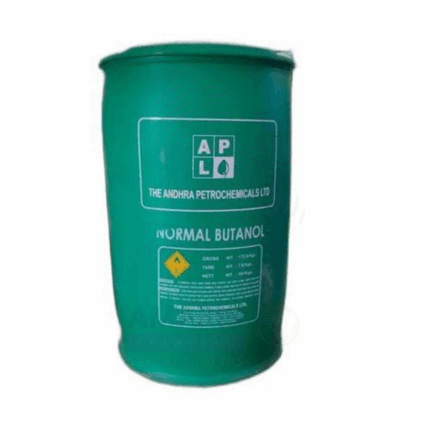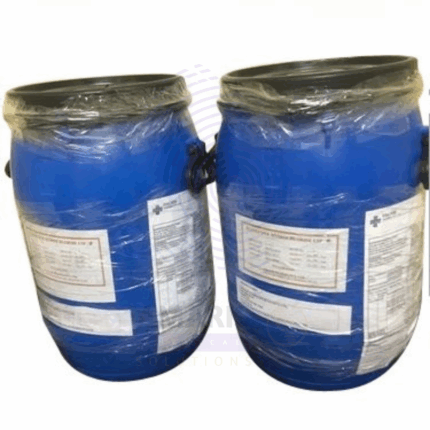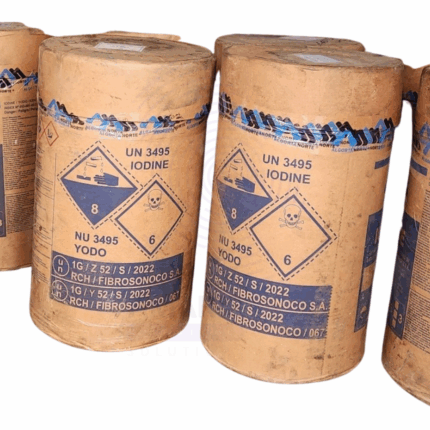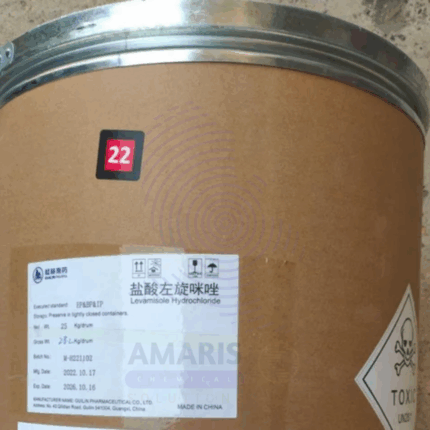Clotrimazole BP
Clotrimazole BP is a broad-spectrum antifungal agent belonging to the imidazole class. It appears as a white to off-white crystalline powder that is practically insoluble in water but soluble in organic solvents like ethanol and chloroform. Clotrimazole is widely used in pharmaceutical formulations for the treatment of fungal infections affecting the skin, mucous membranes, and nails. Its mechanism involves inhibition of ergosterol synthesis, a vital component of fungal cell membranes, leading to increased cell permeability and fungal cell death. BP2000 indicates compliance with British Pharmacopoeia standards ensuring high purity and consistent quality suitable for pharmaceutical applications.
Clotrimazole BP Uses
Primary Uses
Pharmaceuticals & Healthcare
- Used extensively in topical formulations (creams, ointments, lotions) for treating superficial fungal infections such as athlete’s foot (tinea pedis), ringworm (tinea corporis), jock itch (tinea cruris), and candidiasis.
- Incorporated in vaginal suppositories and creams for the treatment of vulvovaginal candidiasis.
- Utilized in oral lozenges and troches for oropharyngeal candidiasis (thrush).
- Active ingredient in medicated powders and sprays for fungal infections in intertriginous areas.
- Sometimes formulated in nail lacquers for onychomycosis (fungal nail infections).
Secondary Uses
Veterinary Medicine
- Used topically in veterinary antifungal preparations for fungal infections in animals.
Cosmetics & Personal Care
- Occasionally incorporated in antifungal deodorants and foot-care products to prevent fungal growth and odor.
Research & Development
- Employed in laboratory research studying antifungal mechanisms and resistance patterns.
- Used in development of new antifungal delivery systems such as nanoparticles and controlled-release formulations.
Basic Identification Attributes
- Chemical Name (IUPAC): 1-[(2-Chlorophenyl)(diphenyl)methyl]-1H-imidazole
- Common/Trade Name: Clotrimazole
- CAS Number: 23593-75-1
- HS Code: 2933.69.90
- Molecular Formula: C22H17ClN2
- Synonyms:
- 1-[(2-Chlorophenyl)(diphenyl)methyl]imidazole
- Canesten (brand)
- Physical & Chemical Properties
- Physical State: White to off-white crystalline powder
- Color & Odor: White/off-white; odorless to faint aromatic
- Melting Point: 147–150 °C
- Boiling Point: Not applicable (decomposes)
- Density: Approx. 1.27 g/cm³
- Solubility:
- Practically insoluble in water (<0.1 mg/mL)
- Soluble in ethanol, methanol, chloroform, DMSO
- Stability: Stable under normal conditions; sensitive to light and moisture over prolonged exposure
- Safety & Hazard Attributes
- Hazard Class (GHS): Not classified as hazardous but may cause skin or eye irritation
- NFPA Ratings:
- Health: 1
- Flammability: 1
- Reactivity: 0
- Exposure Limits: No established occupational exposure limits
- Toxicity: Low systemic toxicity; possible mild skin sensitization or irritation in sensitive individuals
- Reactivity: Stable; avoid strong oxidizers and acids
- Storage & Handling Attributes
- Storage Conditions: Store in tightly closed containers in a cool, dry, dark place away from direct sunlight and moisture
- Container Type: Amber glass or plastic containers with airtight seals
- Shelf Life: 2–3 years when stored properly
- Special Handling: Use PPE (gloves, mask) to avoid dust inhalation; handle in well-ventilated areas
- Regulatory & Compliance Attributes
- BP Status: Complies with British Pharmacopoeia 2000 standards
- FDA Status: Approved for pharmaceutical use as antifungal active ingredient
- REACH Status: Registered
- Transportation: Non-hazardous under normal transport regulations
- Waste Disposal: Dispose according to pharmaceutical waste guidelines
- Environmental & Health Impact
- Ecotoxicity: Low environmental impact; not highly toxic to aquatic organisms at environmental levels
- Persistence: Moderate persistence; biodegrades slowly
- Bioaccumulation: Low potential
- Carcinogenicity/Mutagenicity: Not classified as carcinogenic or mutagenic
Biodegradability: Slowly biodegradable
-
Safety Handling Precautions
- PPE: Wear gloves, dust mask, and protective eyewear during handling
- Handling: Avoid dust generation; handle in well-ventilated areas or under fume hoods
- Storage: Keep containers tightly sealed, away from heat and light
- Hygiene: Wash hands after handling; avoid ingestion, inhalation, and eye contact
First Aid Measures
- Inhalation: Move to fresh air; if symptoms such as coughing or dizziness develop, seek medical attention
- Skin Contact: Wash skin with soap and water; seek medical help if irritation persists
- Eye Contact: Rinse immediately with plenty of water for at least 15 minutes; seek medical attention
- Ingestion: Rinse mouth with water; do not induce vomiting; seek medical advice immediately
Firefighting Measures
- Fire Hazards: Combustible if exposed to high temperatures or flame
- Extinguishing Media: Use dry chemical, foam, or CO₂ extinguishers
- Special Precautions: Firefighters should wear protective clothing and self-contained breathing apparatus
- Decomposition Products: May emit toxic fumes including nitrogen oxides, hydrogen chloride, and carbon monoxide when burned


 Preservatives(food)
Preservatives(food) Flavor Enhancers
Flavor Enhancers Acidulants
Acidulants Sweeteners
Sweeteners Antioxidants
Antioxidants Colorants(food)
Colorants(food) Nutraceutical Ingredients (food)
Nutraceutical Ingredients (food) Nutrient Supplements
Nutrient Supplements Emulsifiers
Emulsifiers
 Collectors
Collectors Dust Suppressants
Dust Suppressants Explosives and Blasting Agents
Explosives and Blasting Agents Flocculants and Coagulants
Flocculants and Coagulants Frothers
Frothers Leaching Agents
Leaching Agents pH Modifiers
pH Modifiers Precious Metal Extraction Agents
Precious Metal Extraction Agents
 Antioxidants(plastic)
Antioxidants(plastic) Colorants (Pigments, Dyes)
Colorants (Pigments, Dyes) Fillers and Reinforcements
Fillers and Reinforcements Flame Retardants
Flame Retardants Monomers
Monomers Plasticizers
Plasticizers Polymerization Initiators
Polymerization Initiators Stabilizers (UV, Heat)
Stabilizers (UV, Heat)
 Antifoaming Agents
Antifoaming Agents Chelating Agents
Chelating Agents Coagulants and Flocculants
Coagulants and Flocculants Corrosion Inhibitors
Corrosion Inhibitors Disinfectants and Biocides
Disinfectants and Biocides Oxidizing Agents
Oxidizing Agents pH Adjusters
pH Adjusters Scale Inhibitors( water)
Scale Inhibitors( water)
 Antioxidants(cosmetic)
Antioxidants(cosmetic) Emollients
Emollients Fragrances and Essential Oils
Fragrances and Essential Oils Humectants
Humectants Preservatives
Preservatives Surfactants(cosmetic)
Surfactants(cosmetic) Thickeners
Thickeners UV Filters
UV Filters
 Fertilizers
Fertilizers Soil Conditioners
Soil Conditioners Plant Growth Regulators
Plant Growth Regulators Animal Feed Additives
Animal Feed Additives Biostimulants
Biostimulants Pesticides (Herbicides, Insecticides, Fungicides)
Pesticides (Herbicides, Insecticides, Fungicides)
 Active Pharmaceutical Ingredients (APIs)
Active Pharmaceutical Ingredients (APIs) Excipients
Excipients Solvents(pharmaceutical)
Solvents(pharmaceutical) Antibiotics
Antibiotics Antiseptics and Disinfectants
Antiseptics and Disinfectants Vaccine Adjuvants
Vaccine Adjuvants Nutraceutical Ingredients (pharmaceutical)
Nutraceutical Ingredients (pharmaceutical) Analgesics & Antipyretics
Analgesics & Antipyretics
 Analytical Reagents
Analytical Reagents Solvents(lab)
Solvents(lab) Chromatography Chemicals
Chromatography Chemicals Spectroscopy Reagents
Spectroscopy Reagents microbiology-and-cell-culture-reagents
microbiology-and-cell-culture-reagents Molecular Biology Reagents
Molecular Biology Reagents Biochemical Reagents
Biochemical Reagents Inorganic and Organic Standards
Inorganic and Organic Standards Laboratory Safety Chemicals
Laboratory Safety Chemicals Specialty Laboratory Chemicals(Special Laboratory Equipment)
Specialty Laboratory Chemicals(Special Laboratory Equipment)
 Demulsifiers
Demulsifiers Hydraulic Fracturing Fluids
Hydraulic Fracturing Fluids Scale Inhibitors(oil)
Scale Inhibitors(oil) Surfactants(oil)
Surfactants(oil) Drilling Fluids
Drilling Fluids
 Dyes and Pigments
Dyes and Pigments Bleaching Agents
Bleaching Agents Softening Agents
Softening Agents Finishing Agents
Finishing Agents Antistatic Agents
Antistatic Agents
 Admixtures
Admixtures Waterproofing Agents
Waterproofing Agents Sealants and Adhesives
Sealants and Adhesives Curing Compounds
Curing Compounds Concrete Repair Chemicals
Concrete Repair Chemicals Anti-Corrosion Coatings
Anti-Corrosion Coatings
 Surfactants(cleaning)
Surfactants(cleaning) Builders
Builders Enzymes
Enzymes Solvents (Cleaning)
Solvents (Cleaning) Fragrances
Fragrances
 Electronic Chemicals
Electronic Chemicals Catalysts
Catalysts Lubricants
Lubricants Photographic Chemicals
Photographic Chemicals Refrigerants
Refrigerants Automotive chemicals
Automotive chemicals Pyrotechnic Chemicals
Pyrotechnic Chemicals
 Biodegradable Surfactants
Biodegradable Surfactants Bio-based Solvents
Bio-based Solvents Renewable Polymers
Renewable Polymers Carbon Capture Chemicals
Carbon Capture Chemicals Wastewater Treatment Chemicals
Wastewater Treatment Chemicals
 Pigments
Pigments Solvents(paint)
Solvents(paint) Specialty Coatings
Specialty Coatings Binders/Resins
Binders/Resins Additives
Additives Driers
Driers Anti-Corrosion Agents
Anti-Corrosion Agents Functional Coatings
Functional Coatings Application-Specific Coatings
Application-Specific Coatings
 Fresh Herbs
Fresh Herbs Ground Spices
Ground Spices Whole Spices
Whole Spices Spice Blends
Spice Blends Dried Herbs
Dried Herbs
 Leavening Agents
Leavening Agents Dough Conditioners
Dough Conditioners Flour Treatments
Flour Treatments Fat Replacers
Fat Replacers Decoratives
Decoratives Preservatives(baking)
Preservatives(baking)
 Plasticizers & Softeners
Plasticizers & Softeners Reinforcing Agents
Reinforcing Agents Adhesion Promoters
Adhesion Promoters Vulcanizing Agents
Vulcanizing Agents Antidegradants
Antidegradants Blowing Agents
Blowing Agents Fillers & Extenders
Fillers & Extenders Accelerators & Retarders
Accelerators & Retarders























